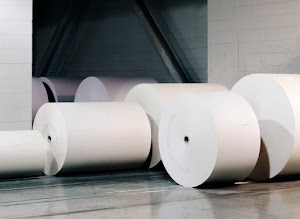 |
| Newsprint rolls (Photo by David Kasnic, The Washington Post) |
"A shortage of truckers and blockade bottlenecks have put a crimp on newsprint deliveries to the nation’s newspapers," Buck Ryan, associate professor of journalism at the University of Kentucky, reports for The Rural Blog.
“The newsprint situation is severe,” Brett Wesner, chair of the National Newspaper Association and publisher of 15 titles in Oklahoma, Texas and New Mexico, told Ryan.
The crunch appears to come from a backlog caused by the blockade by Canadian truckers to protest pandemic restrictions.
This week, Smithson told Ryan, “One supplier recently told us that they had lined up only 76 trucks and drivers for the 872 loads they had planned to ship. That illustrates the scope of the challenge.”
Nolan said small, rural papers are more threatened by the shortage because most of their printers are independently owned "or have newsprint agreements with only one or two mills," not the cooperative. "Some have limited storage capacity. As the paper market gets tighter, trucking delays make just-in-time delivery more problematic." He listed several contributing factors for the shortage, including:
- A decline in demand for newsprint caused mills to close or convert their machines to other types of paper. The pandemic further crushed demand as newspapers closed.
- With fewer mills making newsprint, producers are running near capacity.
- As the pandemic rose, Covid-19 diminished the ability of providers to fully staff remaining producing plants: “Classic supply/demand/production bottleneck.”
- Increased regulations have dramatically raised requirements and training for someone to get a Class A commercial driver's license, causing a national shortage of truck drivers. Gasoline price increases have hurt the trucking industry even further.
- Delays in getting produced paper picked up for shipment has filled mill warehouses and shipping docks to a saturation point.
Nolan is not optimistic the situation will improve soon. “Recently, I was told lack of storage capacity is now hampering production,” he said. “Also, mills are running at such high capacity level, maintenance is curtailed. Now, any breakdown of machinery pushed too hard stops production.”
For Ryan's full story, click here.
No comments:
Post a Comment